I have a data dict (keys represent items (1,2,3..are ids of the items) and their values('712907','742068') refer to users). I convert it into a pandas dataframe:
data_dict = {0: ['712907','742068','326136','667386'],
1: ['667386','742068','742068'],
2: ['326136', '663056', '742068','742068'],
3: ['326136', '663056', '742068'],4: ['326116','742068','663056', '742068'],5: ['326136','326136','663056', '742068']}
df= pd.DataFrame.from_dict(data_dict, orient='index')
I group the items in the dataframe based on the users ('712907','742068','326136'..), see figure below.
dframe = pd.get_dummies(df.stack()).sum(level=0)
sv = sparse.csr_matrix(dframe.as_matrix())
Note that the above dataframe (dframe ) is just a small example, the actual dframe size is (309235 x 81566). Therefore, I want to use spark to compute the cosine similarities between rows (1,2,3...) in sv (sparse matrix). Here what I have achieved so far:
from pyspark.sql import SQLContext
from pyspark.sql.types import Row
sc = pyspark.SparkContext(appName="cosinesim")
sqlContext = SQLContext(sc)
sv_rdd = sc.parallelize(sv.toarray())
Using the example, i convert rdd to a dataframe:
def f(x):
d = {}
for i in range(len(x)):
d[str(i)] = int(x[i])
return d
dfspark = sv_rdd.map(lambda x: Row(**f(x))).toDF()
Following this example, i add a new 'id' column:
row_with_index = Row(*["id"] + dfspark.columns)
def make_row(columns):
def _make_row(row, uid):
row_dict = row.asDict()
return row_with_index(*[uid] + [row_dict.get(c) for c in columns])
return _make_row
f = make_row(dfspark.columns)
dfidx = (dfspark.rdd
.zipWithIndex()
.map(lambda x: f(*x))
.toDF(StructType([StructField("id", LongType(), False)] + dfspark.schema.fields)))
Finally, compute similarities between rows by transposing the matrix:
pred = IndexedRowMatrix(dfidx.rdd.map(lambda row: IndexedRow(row.id,row[1:])))
pred1 = pred.toBlockMatrix().transpose().toIndexedRowMatrix()
pred_sims = pred1.columnSimilarities()
How can I obtain top-k ids for each items 0,1,2,3,4 based on the cosine similarities(pred_sims)? I convert the CoordinateMatrix into a dataframe, but unsure how to access the top-k items for each ids..
columns = ['from', 'to', 'sim']
vals = pred_sims.entries.map(lambda e: (e.i, e.j, e.value)).collect()
dfsim = sqlContext.createDataFrame(vals, columns)
dfsim.show()
from pyspark.sql.functions import col, desc
for i in range(m):
target_id = int(dataset_u[i])
dfFrom = dfsim.where((col("from") == target_id))
.....

